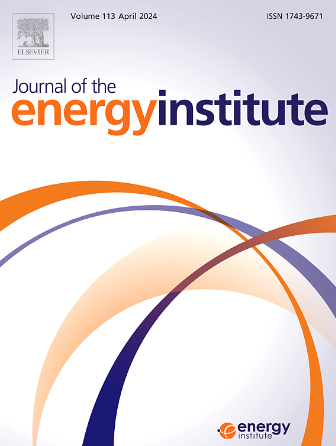Study on the impact factors and kinetic analysis of thermal transportation process of semi coke from pulverize coal pyrolysis
IF 5.6
2区 工程技术
Q2 ENERGY & FUELS
引用次数: 0
Abstract
Thermal transportation is a crucial link between the pyrolysis of coal powder and the application of the main product semi coke powder. Taking the semi coke from a 10,000-ton industrial experimental pyrolysis device as the raw material, based on its non-isothermal TG-FTIR (Thermogravimetry-Fourier Transform Infrared Spectroscopy) experiment, an isothermal TG-FTIR experiment was conducted to simulate the thermal conveying process. The non-isothermal TG-FTIR experiment reveales that under different heating rates, the oxidation reaction of semi coke occurs around 300 °C. With the increase in the heating rate, the ignition temperature, maximum weight loss rate temperature, burnout temperature and maximum weight loss rate of the semi coke all increase accordingly. The isothermal TG-FTIR experiment indicates that as the temperature and oxygen content increase, the oxidation reaction is intensified significantly. The yield of major gaseous products such as CO2, H2O, and CO increase accordingly, but the output of CH4 remains small as the lack of volatile content. The kinetics of the non-isothermal and isothermal oxidation processes were comparatively analyzed using various methods, and the calculation results showed good consistency. With the increase of semi coke conversion rate, the activation energy gradually decreases under non-isothermal oxidation conditions and the average values are 86.44 kJ mol−1 (FWO method) and 73.88 kJ mol−1 (KAS method), while it gradually increases under isothermal oxidation conditions and the average values are 71.45 kJ mol−1 (model-free method) and 93.66 kJ mol−1 (first-order reaction model method).
煤粉热解半焦热输运过程影响因素及动力学分析
热输运是煤粉热解与主要产品半焦粉应用之间的关键环节。以某万吨级工业实验热解装置的半焦为原料,基于其非等温TG-FTIR(热重-傅里叶变换红外光谱)实验,进行等温TG-FTIR实验,模拟热输送过程。非等温TG-FTIR实验表明,在不同升温速率下,半焦在300℃左右发生氧化反应。随着升温速率的增大,半焦的着火温度、最大失重速率温度、燃尽温度和最大失重速率均相应增大。等温TG-FTIR实验表明,随着温度和氧含量的升高,氧化反应明显加剧。CO2、H2O、CO等主要气态产物的产率相应增加,但由于挥发份较少,CH4的产率仍然很小。采用各种方法对非等温氧化和等温氧化过程动力学进行了比较分析,计算结果具有较好的一致性。随着半焦转化率的增加,非等温氧化条件下的活化能逐渐减小,平均为86.44 kJ mol−1 (FWO法)和73.88 kJ mol−1 (KAS法);等温氧化条件下的活化能逐渐增大,平均为71.45 kJ mol−1(无模型法)和93.66 kJ mol−1(一阶反应模型法)。
本文章由计算机程序翻译,如有差异,请以英文原文为准。
求助全文
约1分钟内获得全文
求助全文
来源期刊

Journal of The Energy Institute
工程技术-能源与燃料
CiteScore
10.60
自引率
5.30%
发文量
166
审稿时长
16 days
期刊介绍:
The Journal of the Energy Institute provides peer reviewed coverage of original high quality research on energy, engineering and technology.The coverage is broad and the main areas of interest include:
Combustion engineering and associated technologies; process heating; power generation; engines and propulsion; emissions and environmental pollution control; clean coal technologies; carbon abatement technologies
Emissions and environmental pollution control; safety and hazards;
Clean coal technologies; carbon abatement technologies, including carbon capture and storage, CCS;
Petroleum engineering and fuel quality, including storage and transport
Alternative energy sources; biomass utilisation and biomass conversion technologies; energy from waste, incineration and recycling
Energy conversion, energy recovery and energy efficiency; space heating, fuel cells, heat pumps and cooling systems
Energy storage
The journal''s coverage reflects changes in energy technology that result from the transition to more efficient energy production and end use together with reduced carbon emission.
 求助内容:
求助内容: 应助结果提醒方式:
应助结果提醒方式:


